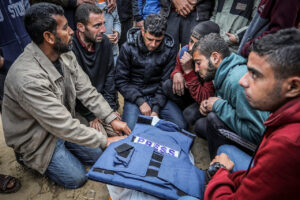How operating drones became a death sentence for Gaza’s journalists

Illustrative photo showing Palestinians mourning the journalist Ahmed Shiah after he was killed in an Israeli airstrike, Nasser Hospital, Khan Younis, southern Gaza, 15 January 2025
Youssr Youssef and Magdalena Hervada report in +972 on 27 March 2025:
On Feb. 15, 2024, the UN Relief and Works Agency for Palestine Refugees (UNRWA) published images from Gaza’s Al-Shati refugee camp that were seen around the world. Four months after the start of Israel’s war on the Strip following the Hamas attacks of October 7, for many viewers it was the first time they were able to get a true sense of the scale of the destruction in the north of the enclave: dozens of gutted and partially collapsed buildings, the ruins stretching as far as the horizon.
Abdallah Al-Hajj filmed these images by drone. Nine days after they were posted online, on Feb. 24, the Palestinian journalist was maimed in an Israeli airstrike, which killed his 18-year-old nephew and a fisherman. Al-Hajj, who lost both of his legs in the attack, explained that he had worked for UNRWA for over 10 years and is convinced that he was deliberately targeted by the Israeli army multiple times during the current war.
“Two days after I was targeted, my house was hit,” he said. “Why? To destroy the archives [of images I had] accumulated over 20 years from the entire Gaza Strip. Only a few images [now] remain.”
At the time, Al-Hajj was one of the few journalists left in northern Gaza, after the Israeli army ordered residents to evacuate to the south. Al-Hajj could not abandon his parents, who were too old to make the arduous crossing. Some of the people he came across during his reporting had resorted to eating animal feed. “Every time they saw me with my drone and camera, they asked me to show the world what was happening in Gaza,” he explained in an interview with our partners at Le Monde. So he returned to Al-Shati camp.
On the day he was wounded in the strike, he had used his drone to film only briefly — around “five minutes” — and “not very high, at around 50 meters” above his head, as his images confirm. Moreover, the Israeli army had by then already “wrapped up” a two-week ground operation in the area earlier that day. Yet even absent any evidence of ground troops, Al-Hajj was still attacked.
“If I had been targeted in an area [where there were military operations], they would have said to me, ‘By God, Abdallah, it’s not reasonable to have used your drone [there].’ But here, I was in an area far from everything, near the sea, in an open space,” Al-Hajj said.
In response to a query about the strike, the Israeli army claimed to have “used an Israeli air force plane to eliminate” a “terrorist cell using a drone, posing an imminent threat to forces in the Shati area.” But as Al-Hajj noted, “if I did belong to Hamas, I would never have been able to leave the Gaza Strip to receive medical treatment” (Al-Hajj left Gaza with authorization in April 2024 before receiving treatment in Qatar).
Since October 7, at least five Palestinian journalists who used drones to document Gaza’s destruction have been killed or seriously wounded by deliberate Israeli strikes. The testimonies of their surviving colleagues, corroborated by exchanges with Israeli military sources, demonstrate the absence of clear rules given to soldiers to distinguish between combatants and journalists filming with drones.
